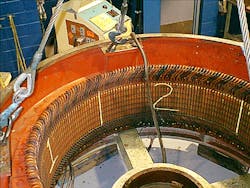In the real world, it is impossible to balance line-to-line voltages perfectly in a 3-phase circuit. In fact, line voltages typically differ by a few volts or more. But a difference that exceeds 1% can lead to serious trouble on the plant floor. To maintain peak energy efficiency and thwart premature failure of 3-phase motors, it makes sense to install adequate protective devices and periodically check for voltage unbalance at the motor terminals.
Simply stated, voltage unbalance describes the condition when not all line voltages in a 3-phase circuit are equal. How this will affect motors (Photo) and other devices in the circuit depends directly upon the percent of unbalance that is present. The National Electrical Manufacturers Association (NEMA) defines percent voltage unbalance as follows in its standards publication MG 1-2011: Motors and Generators, Part 14.36:
% voltage unbalance = 100 x [(maximum voltage deviation from average voltage) ÷ (average voltage)]
With line-to-line voltages of 460V, 467V and 450V, for example, the average voltage is 459V, and the maximum deviation from average is 9V. Therefore, the percent unbalance is calculated as follows:
100 x [9V ÷ 459V] = 1.96%
Acknowledging possible differences in performance, NEMA MG 1-2011, Part 12.45, calls for 3-phase motors to “operate successfully” at rated load if voltage unbalance at the motor terminals is 1% or less. For reliable motor operation, be sure to keep this limiting value in mind. (Note that the 1.96% unbalance in the above example exceeds the NEMA standard.)
Redistributing and reconnecting single-phase loads can reduce voltage unbalance caused by excessively unequal load distribution among phases. The most prevalent culprits among heavy, single-phase loads are lighting equipment and occasionally welders. A blown fuse on a bank of 3-phase power factor improvement capacitors could also cause the problem.




